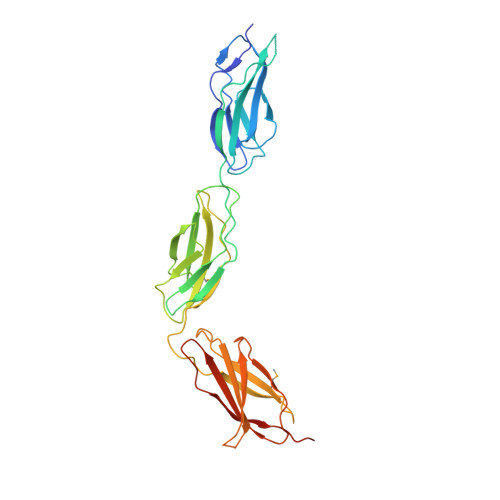Dimerization of Tie2 mediated by its membrane-proximal FNIII domains.
Moore, J.O., Lemmon, M.A., Ferguson, K.M.(2017) Proc Natl Acad Sci U S A 114: 4382-4387
- PubMed: 28396397
- DOI: https://doi.org/10.1073/pnas.1617800114
- Primary Citation of Related Structures:
5UTK - PubMed Abstract:
Tie1 and Tie2, members of the tyrosine kinase family with immunoglobulin and EGF homology domains, are receptor tyrosine kinases found primarily in endothelial cells with key roles in development and maintenance of the vasculature and in angiogenesis. They are attractive targets for therapeutic intervention in tumor angiogenesis, inflammation, and sepsis. Tie2 is regulated directly by the multimeric angiopoietin (Ang) ligands, with Ang1 being its primary activator. Structural studies have shown how Angs bind to the Tie2 ligand-binding region, but do not explain Tie2 activation and suggest a passive role for the Tie2 extracellular region (ECR) in ligand-induced receptor dimerization. Here we show that the Tie2 ECR forms strong dimers even in the absence of bound ligand. Dimerization is mediated by membrane-proximal fibronectin type III (FNIII) domains that were omitted in previous structural studies. We describe a 2.5-Å resolution X-ray crystal structure of the membrane-proximal three Tie2 FNIII domains, Tie2(FNIIIa-c), revealing two possible dimerization modes that primarily involve the third FNIII domain, FNIIIc. Mutating these dimer interfaces implicates one of them (dimer 1) in soluble Tie2 (sTie2) dimerization in solution but suggests that both could play a role in Ang1-induced Tie2 activation, possibly modulated by Tie1. Through small-angle X-ray scattering studies of sTie2 dimers in solution and modeling based on crystal structures, we suggest that Ang1 binding may cross-link Tie2 dimers into higher-order oligomers, potentially explaining how Tie2 is differentially clustered following ligand engagement in different cellular contexts. Our results also firmly implicate FNIII domain-mediated interactions in Tie2 activation, identifying a potential Achilles' heel for therapeutic inhibition.
Organizational Affiliation:
Department of Biochemistry and Biophysics, University of Pennsylvania Perelman School of Medicine, Philadelphia, PA 19104.

















